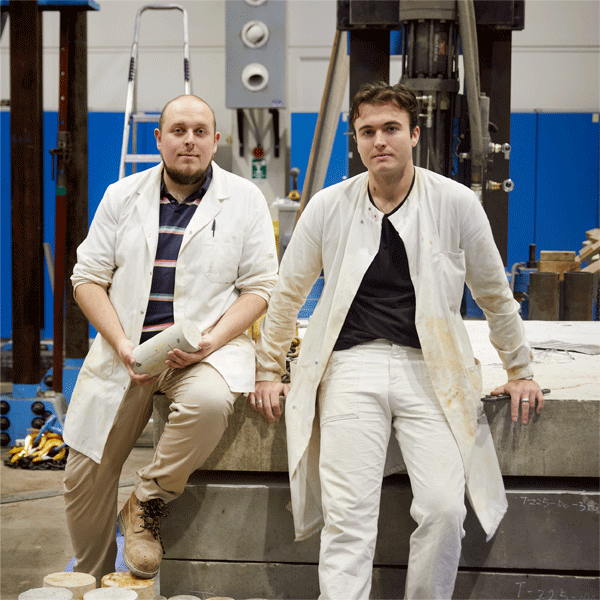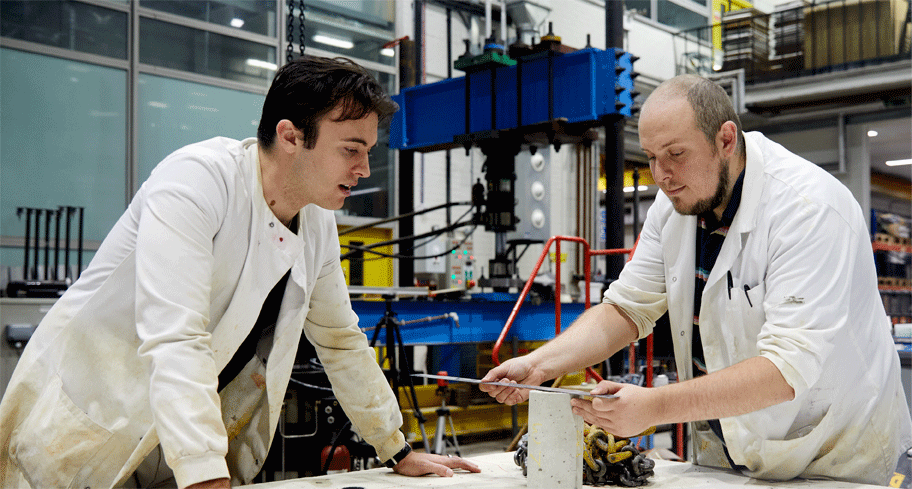Emissions
2022A technology developed by PhD students at Imperial College London is considered by the jury to best represent the focus of 2022, which is: seminal architectural solutions which are CO2 neutral (or less), factoring in all embodied emissions.
THE SERATECH PROCESS
PhD students at Imperial College London, Sam Draper and Barney Shanks, have found a way to produce carbon-neutral concrete.
The team, which consists of material scientists and engineers, has developed an efficient, low-cost process to capture CO2 emissions directly from industrial flues. The process captures and stores all the CO2 through a chemical process, which also yields a cement additive – a silica – that can replace the amount of Portland cement in the concrete mix by up to 40%. The carbon capture associated with producing the silica means the concrete products can be zero carbon.
The raw materials used in Seratech’s process – waste CO2 and a magnesium silicate mineral – are naturally abundant all over the globe. Furthermore, the process integrates into existing manufacturing lines and the equipment used in concrete production. As such, it is possible to implement in every cement plant around the world and does not require major shifts in current practices or mindsets.
Given the huge carbon footprint of the construction industry, Seratech’s process has the potential to significantly reduce embodied emissions globally and to support future low-carbon construction.
Seratech is currently developing the design of a pilot plant to model the process at large scale.

JURY’S STATEMENT
The accelerating climate crisis has spurred self-examination within the construction industry and a new focus on the design of buildings as well as the use of materials and resources.
Concrete has been used for millennia to construct houses, cities, and critical infrastructure. The material has helped improve the lives of billions of people worldwide and is essential to continue to raise living standards in all parts of the world.
However, concrete is also responsible for significant CO2 emissions. As things stand now, architecture and the construction industry as a whole cannot function without concrete. This is a dilemma. Tackling the CO2 emissions released in the production of concrete is therefore a main concern.
Seratech is working on an ambitious yet simple solution for how to make carbon-neutral concrete. Importantly, the technology can be integrated into the existing processes and production lines globally.
Once scaled-up and implemented, Seratech has the potential to significantly reduce overall carbon emissions from the construction industry. Hopefully, the 2022 OBEL AWARD can play a part in achieving this pivotal and common goal.
The OBEL AWARD jury believe it is necessary to encourage ambitious cross-disciplinary ideas that do not just provide a temporary or a small-scale fix nor an unrealistic major shift in current practices. We wish for the OBEL AWARD to act as an incentive and inspiration to everyone in the construction industry to work together for a zero-carbon future.

SERATECH BUSINESS HISTORY
Seratech is a private limited company, formed by staff and researchers based at Imperial College London.
It was incorporated on 7 July 2021 to commercialise research arising from its co-founders Sam Draper and Barney Shanks in the field of CO2 capture and construction material innovation. The technology has been in development since late 2020.
In August 2021, the team was accepted into the Greenhouse, a climate-tech accelerator founded by The Centre for Climate Change Innovation (CCCI) and The Royal Institution.
In December 2021 and January 2022, the team won two grants totalling £212k to hire three further researchers to assist in the development of the process and products.
The patent application for the core technology was filed with the UK and European patent offices in January 2022.
Seratech is featured as a case study in The Green Construction Board’s “Low Carbon Concrete Routemap” and listed as a technology with the highest potential impact to reduce the sector’s carbon emissions.
The team, which consists of material scientists and engineers, has developed an efficient, low-cost process to capture CO2 emissions directly from industrial flues. The process captures and stores all the CO2 through a chemical process, which also yields a cement additive – a silica – that can replace the amount of Portland cement in the concrete mix by up to 40%. The carbon capture associated with producing the silica means the concrete products can be zero carbon.






